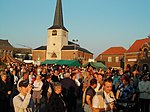Rumst
Antwerp geography stubsMunicipalities of Antwerp ProvincePopulated places in Antwerp ProvinceRumst

Rumst (Dutch pronunciation: [rʏmst], old spelling: Rumpst) is a municipality located in the Belgian province of Antwerp. Since 1976 the municipality not only comprises Rumst proper but also the towns of Reet (old spelling: Reeth) and Terhagen, which were independent municipalities before that year. Industry in Rumst, like Boom, was heavily focused around the production of clay products like bricks. This industry has largely disappeared after 1970. In Rumst, the river Rupel starts as a combination of the Dijle and Nete (river) rivers. In 2021, Rumst had a total population of 15,146. The total area is 19.90 km² (7.7 sq mi).
Excerpt from the Wikipedia article Rumst (License: CC BY-SA 3.0, Authors, Images).Rumst
Catenbergstraat,
Geographical coordinates (GPS) Address Nearby Places Show on map
Geographical coordinates (GPS)
| Latitude | Longitude |
|---|---|
| N 51.083333333333 ° | E 4.4166666666667 ° |
Address
Cummins Logistics
Catenbergstraat 3
2840 (Rumst)
Antwerp, Belgium
Open on Google Maps









